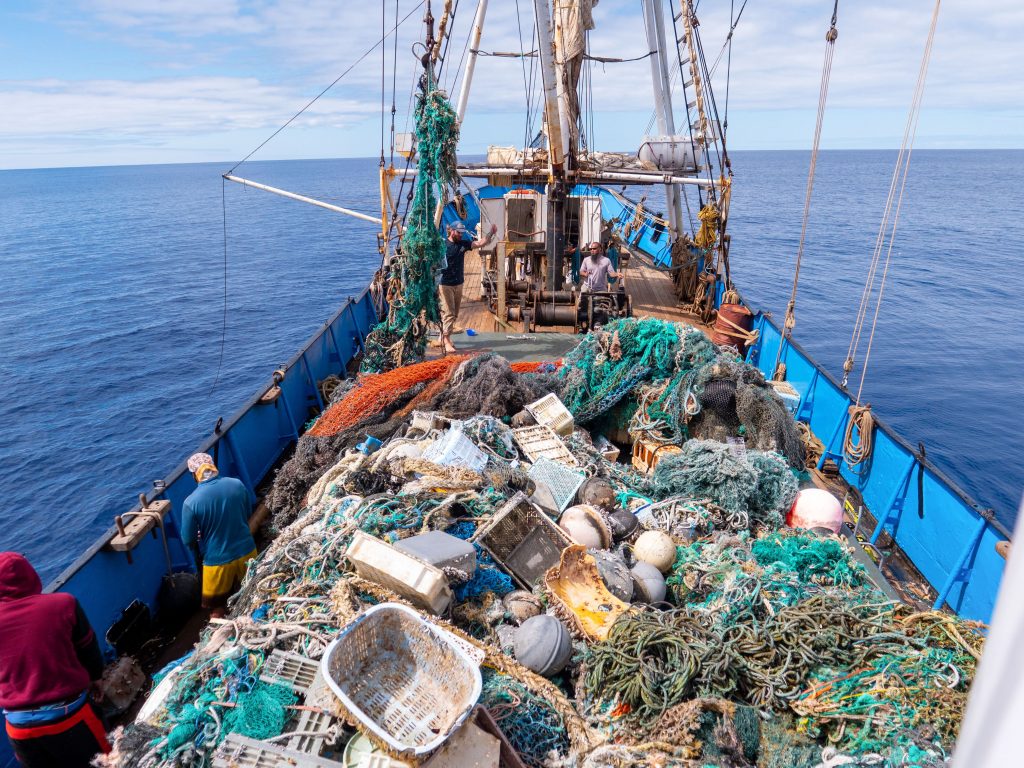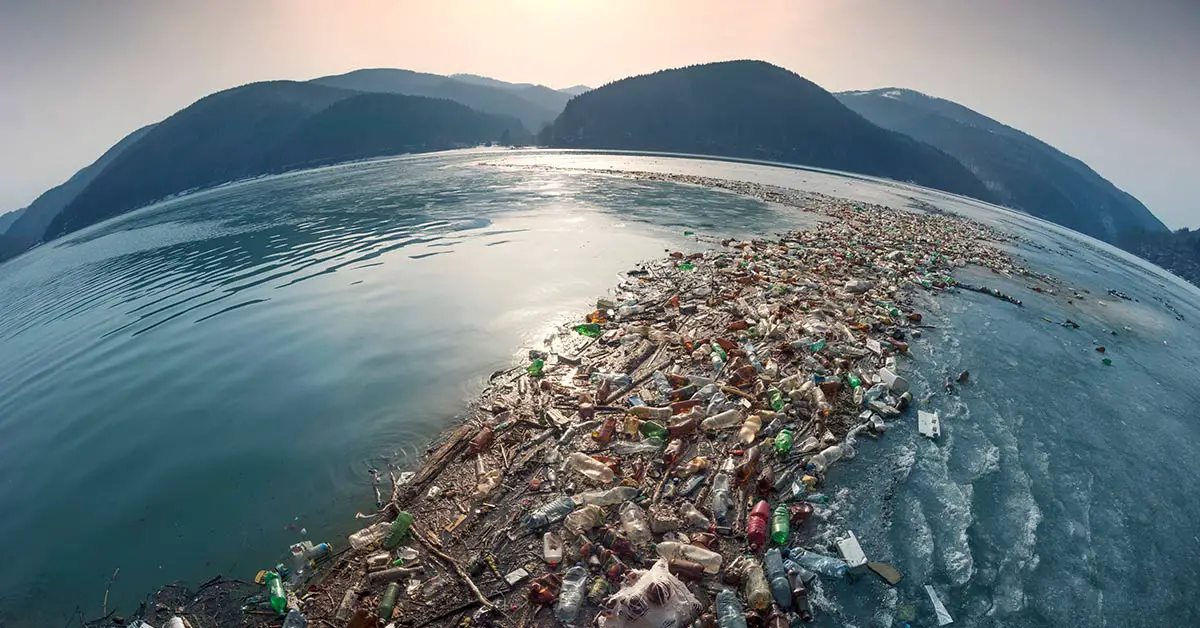There is a place in the world called The Great Pacific Garbage Patch, and it has a major problem- it’s loaded with ocean trash. A group of ocean activists from Hawaii decided to take on the floating island of garbage themselves and ended up removing a record-breaking amount of plastic waste from the ocean.
The Great Pacific Garbage Patch: An Island of Ocean Trash
Also known as the Pacific Trash Vortex, The Great Pacific Garbage Patch is a giant mass of spinning ocean trash. The area stretches from the North American West Coast all the way to Japan. It’s divided into two sections (1):
- The western garbage patch near Japan
- The eastern garbage patch between the United States of Hawaii and California
The North Pacific Subtropical Convergence Zone connects the two sections a few hundred kilometers north of Hawaii. Here the warm waters from the South Pacific intersect the cold water coming up from the Arctic. This acts like a freeway for garbage, transporting ocean trash from one section to the other. (1)
A Vortex of Ocean Trash
It is called a vortex because of the gyre, or large system of swirling ocean currents, that forms. The North Pacific Subtropical Gyre is four clockwise-rotating currents that cover 7.7 million square miles (20 million square kilometers). (1)
National Geographic uses this example to explain the movement of the debris:
“The area in the center of a gyre tends to be very calm and stable. The circular motion of the gyre draws debris into this stable center, where it becomes trapped. A plastic water bottle discarded off the coast of California, for instance, takes the California Current south toward Mexico. There, it may catch the North Equatorial Current, which crosses the vast Pacific. Near the coast of Japan, the bottle may travel north on the powerful Kuroshiro Current. Finally, the bottle travels westward on the North Pacific Current. The gently rolling vortexes of the Eastern and Western Garbage Patches gradually draw in the bottle.” (1)

Image Credit: The Ocean Institute
Garbage discarded on a beach in California can travel all the way to Japan and vice versa. Non-biodegradable plastic makes up the majority of this trash, so it accumulates over time. It does, however, break down into microplastics. We can’t see these with the human eye, but they end up in our environment and food chain. Not only is this is incredibly dangerous to the health of our oceans and the plant and animal life in them, they eventually make their way into land ecosystems and affect human health as well. (1)
The Ocean Voyages Institute Makes History
On June 23, 2020, the Ocean Voyages Institute returned from a 48-hour mission into The Great Pacific Garbage Patch. With them, they brought in 103 tons of plastic ocean trash and fishing nets. This was a record-breaking haul, more than doubling its previous record from a 25-day mission they undertook the previous year. [2, 3]
The group’s founder and executive director Mary Crowley, aka the “The Ghost Net Buster” is extremely proud of her team. She is responsible for developing highly effective methods to remove large amounts of plastic waste from the Oceans. (3)
“We are utilizing proven nautical equipment to effectively clean-up the oceans while innovating with new technologies,” Crowley said in a press release. “Ocean Voyages Institute has been a leader in researching and accomplishing ocean clean-up for over a decade, granted with less fanfare and attention than others, but with passion and commitment and making meaningful impacts.” (3)
The plan is to upcycle all of the waste that has been collected so that none of it ends up in a landfill. The debris is sorted and used for things such as energy production, insulation, and more. (2, 3)
A Second Mission
Not ones to rest after their first success in June, the crew head out on an even longer, 35-day mission in July 2020. On this trip, they were able to remove another 67 tons of ocean trash from the sea. (4)
In total, they removed 170 tons of ghost nets and plastic debris from the Great Pacific Garbage Patch this summer. This quadruples their record from 2019. (4)
“With plastic set to outnumber fish by 2040, we humans are responsible for the oceans collapsing in my lifetime, and we must set ambitious targets to tackle the problem of plastic in the ocean,” Crowley said on their website. “even with our record-setting clean-up, I know we need to do more, and our 1 million pound goal is my commitment to the essential undertaking of cleaning the oceans of plastic.” (4)
You read that correctly: The institute’s goal is to remove 1 million pounds of plastic from the Pacific Ocean. (4)
What About Covid?
Of course in June 2020, the additional challenge of completing this task was the outbreak of COVID-19 that is still gripping the planet. To ensure the safety of the crew and everyone involved, each person who took part in the voyage completed a three-week self-isolation before launch. They confirmed that each member was healthy and COVID-free before heading into the ocean. (2, 3)
“This summer definitely had its challenges, from COVID-19 and having to quarantine our hard-working crew, to almost not being able to depart on the second leg of our mission due to funding gaps,” said Crowley. “Now I feel like we are on a roll, and the support from around the world has been so encouraging, I know we will reach our million pound goal and keep going cleaning our oceans and encouraging major changes in the use of plastics.” (4)
If you would like to support their cause, you can visit their webpage here to donate and to learn more.
Keep Reading: Deadly skin disease found in dolphins linked to climate change
References
- “Great Pacific Garbage Patch.” National Geographic.
- “Biggest Open Ocean Clean-up Ever!” Ocean Voyages Institute. June 25, 2020.
- “Hawaii Group Sets Record For Largest Haul of Plastic Removed From The Great Pacific Garbage Patch.” Good News Network. June 26, 2020.
- “OCEAN VOYAGES INSTITUTE COMMITS TO REMOVING 1 MILLION POUNDS OF PLASTIC FROM THE OCEAN.” Ocean Voyages Institute. August 5, 2020.

